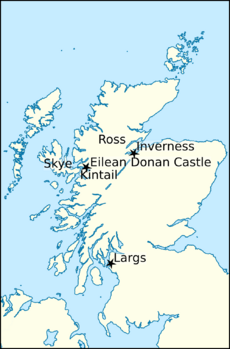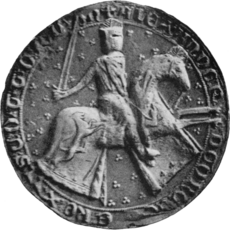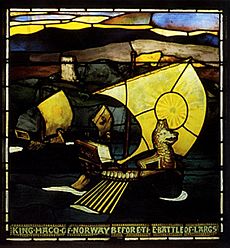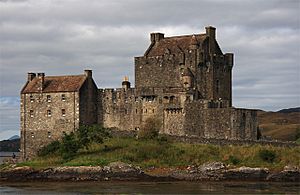Kermac Macmaghan facts for kids
Quick facts for kids
Kermac Macmaghan
|
|
|---|---|

Kermac's name as it appears on folio 121v of AM 45 fol (Codex Frisianus): "Kiarnakr son Makamals".
|
Kermac Macmaghan was a Scottish nobleman who lived in the 1200s. He was active between 1262 and 1264. In 1262, he helped William I, Earl of Ross in a fierce attack in the Hebrides islands. This attack is mentioned in an old Scandinavian story called a saga. It was likely done for Alexander III, King of Scotland. King Alexander wanted to add the Isles to his own kingdom.
The next year, Hákon Hákonarson, King of Norway sailed to the Isles. He wanted to show that Norway still ruled them. But his trip did not go well. After he left and died that same year, the Scots made the main leaders of the Isles agree to their rule. In 1264, Kermac received a payment for his help. An old family tree from the 1400s suggests that Kermac might be the same person as Coinneach mac Mathghamhna. This Coinneach is believed to be an ancestor of Clan Matheson. He might also be an ancestor of Clan Mackenzie.
Scotland Wants the Isles
In the middle of the 1200s, Scottish kings wanted to control the Hebrides islands. These islands were part of the Kingdom of the Isles. But they also belonged to the large Norwegian kingdom. The fact that the islanders were somewhat independent, and the strong presence of the Norwegian King Hákon, worried the Scottish kings.
In 1261, King Alexander III of Scotland sent people to Norway. He wanted to buy the Isles from the Norwegian king. But they could not agree. So, Alexander III decided to invade the Isles. This was a way to challenge Norway's power.
The old story, Hákonar saga Hákonarsonar, says that Kermac helped William I, Earl of Ross in this attack. It says they led Scottish soldiers who burned a town and churches on Skye. They killed many people, including women and children, in a very cruel way. This extreme violence might have been meant to scare the islanders into giving up. The island of Skye was part of the kingdom ruled by Magnús Óláfsson, King of Mann and the Isles. The Earl of Ross likely brought his soldiers from his own large area, the Earldom of Ross.
Norway's Failed Invasion
Because of this attack, King Hákon gathered a huge fleet of ships. He wanted to show Norway's power along the coasts of Scotland. In July 1263, his fleet left Norway. By mid-August, Hákon had confirmed his rule in Shetland and Orkney. He also made the people of Caithness agree to his rule. Then he arrived in the Hebrides.
Hákon met with his local supporters there. He took control of several castles and led raids into the nearby mainland. But bad weather caused some of his ships to be pushed onto the Ayrshire coast. There were some small fights on the shore near Largs. These fights, along with the worsening weather, made the Norwegians lose hope. They decided to go home. After giving parts of the region to his loyal followers, Hákon left the Hebrides. He reached the Northern Isles, where he became sick and died that December.
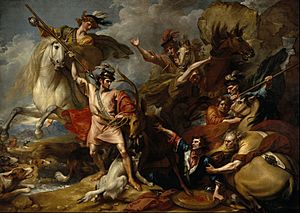
Even though the Hákonar saga Hákonarsonar says Norway won, the campaign was actually a big failure. Hákon did not manage to break Scotland's power. The next year, Alexander III took action. He led several invasions into the Isles and northern Scotland.
An old record from the 1200s, Gesta Annalia I, says that Alexander Comyn, Earl of Buchan, William, Earl of Mar, and Alan Hostarius led one such trip. Heavy fines were collected from the northern parts of Scotland. The people of Caithness had to pay 200 cattle. The Earl of Ross himself had to pay 180 cattle. This large fine on the Earl of Ross might mean that the Scottish king was unhappy with his actions during the conflict. In fact, Alexander Comyn and Alan took 20 cattle from the Earl of Ross's land. They gave these cattle to Kermac as payment for his help.
In 1266, nearly three years after Hákon's failed trip, Scotland and Norway finally agreed to peace. This happened with the Treaty of Perth in July. Hákon's son, Magnús Hákonarson, King of Norway, officially gave up all rights to Mann and the islands on Scotland's west coast. This finally ended the disagreement over Scotland's western islands.
Kermac's Family Connections
Kermac seems to be the same person as Coinneach mac Mathghamhna. This name appears in the family tree of Clan Matheson. This family tree is found in an old book from the 1400s called MS 1467. If this is true, Kermac would be the ancestor who gave the clan its name. The record from 1264 would be the earliest time the Gaelic family name of the clan was written down.
Another clan mentioned in MS 1467 is the nearby Clan Mackenzie. Their family tree could also suggest they came from Coinneach. However, another way to read this source is that both clans share an even older common ancestor.
An old story about Coinneach says he was a young leader from Kintail. He was related to the Mathesons. This story says he spent time in Europe, working for the King of France. After traveling far on a ship given by the king, this leader supposedly came back to Scotland rich and skilled. He was later asked by Alexander II, King of Scotland to build Eilean Donan Castle. The castle we see today was built in the early 1900s. It shows modern romantic ideas more than a real medieval fortress.
A medieval writer named Matthew Paris said that Hugh de Châtillon, Count of Saint-Pol, ordered a large ship to be built at Inverness. This was for the Seventh Crusade. We don't know if Kermac actually went on this crusade with Louis IX, King of France. But some Scottish noblemen certainly did join the king on that journey.


